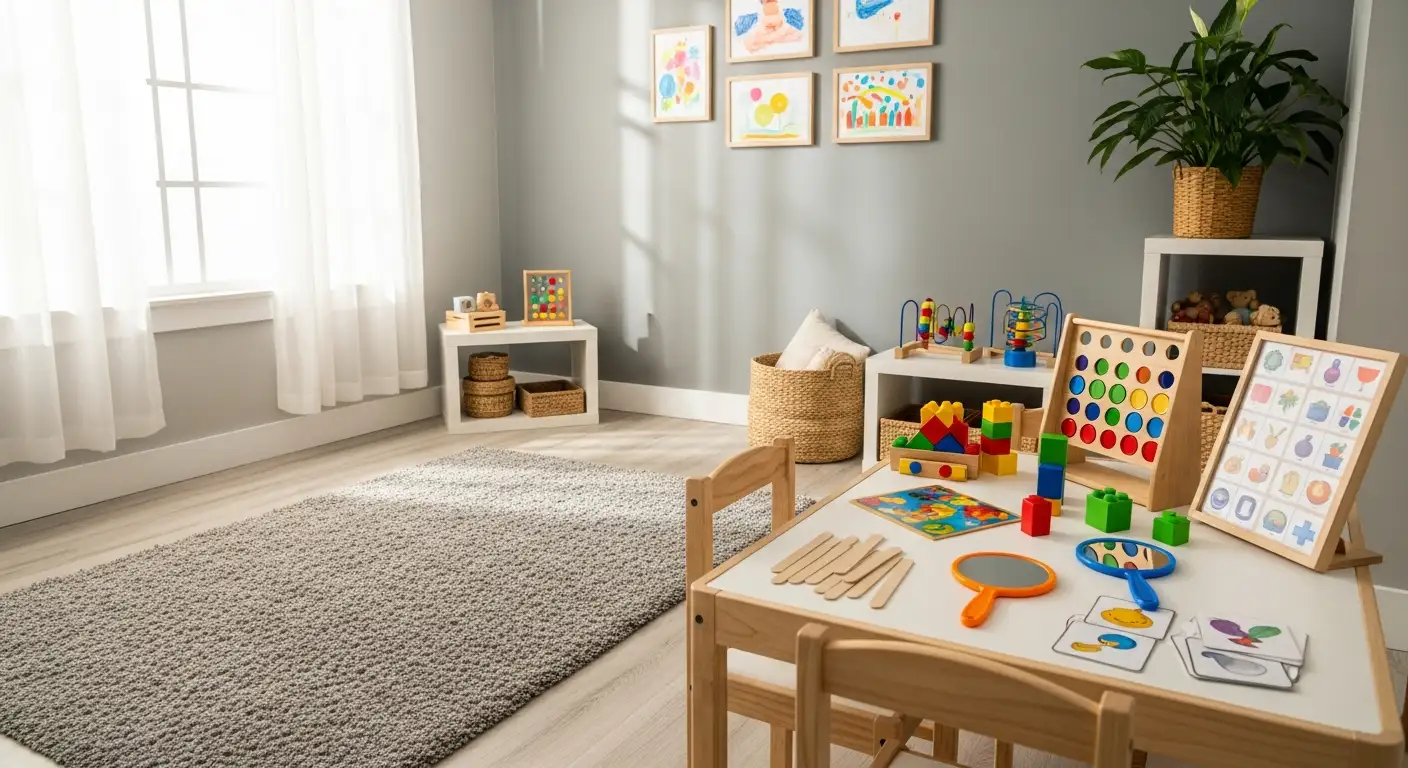Understanding the transformative power of CBT in childhood development
Cognitive Behavioral Therapy (CBT) is a well-established, evidence-based approach that significantly contributes to the emotional, behavioral, and social development of children. Since its emergence in the 1960s, CBT has evolved into a versatile therapeutic modality applied across diverse settings including schools, hospitals, and community centers. This article explores the multifaceted role of CBT in supporting children's mental health, highlighting its principles, techniques, developmental considerations, and empirical support for its effectiveness.
Foundations and Evolution of CBT in Child Therapy
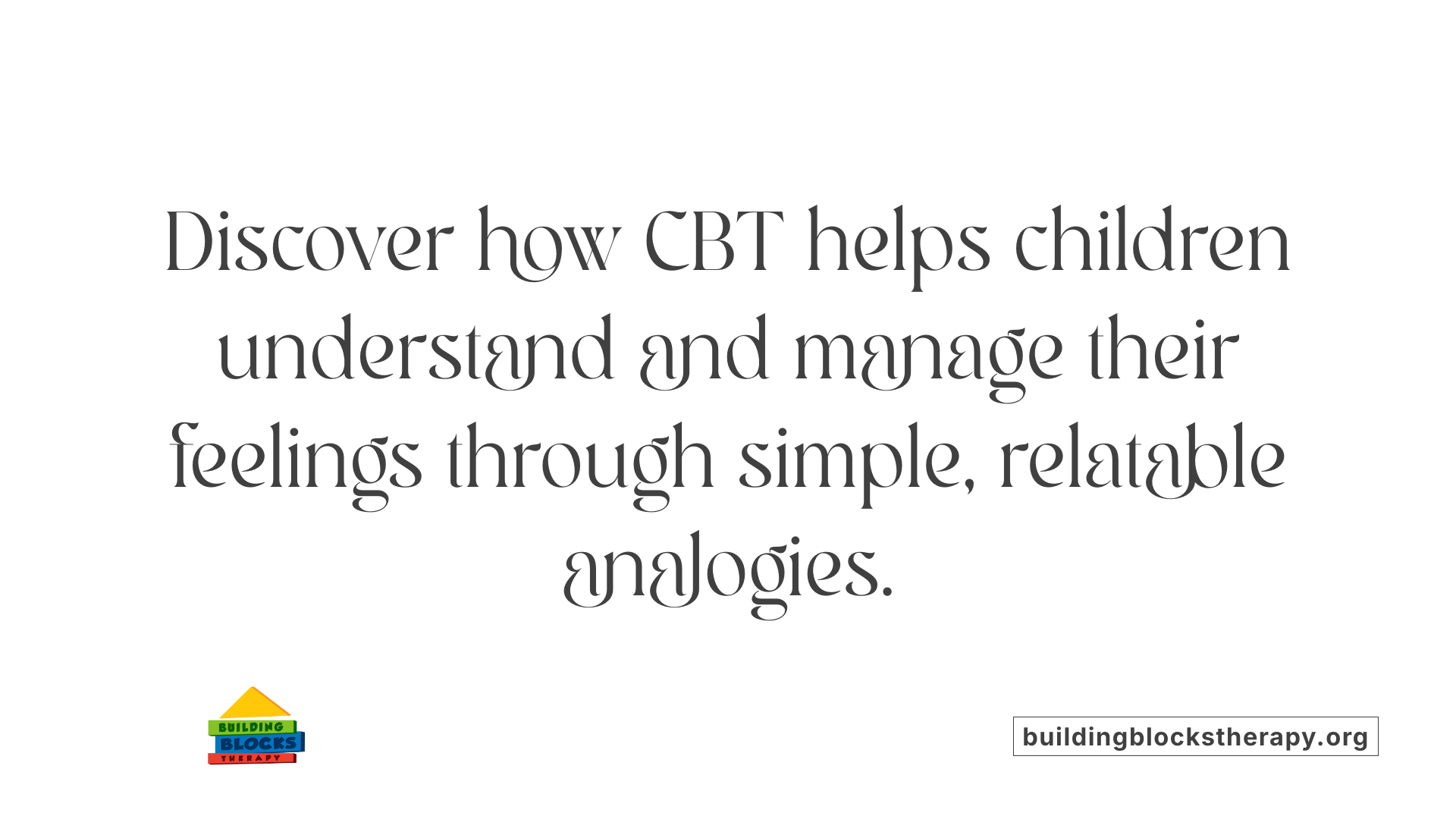
How is CBT explained to children?
Cognitive Behavioral Therapy (CBT) can be made understandable for children by using simple and relatable analogies. For example, therapists might compare their role to that of a sports coach or music teacher—someone who helps the child learn new skills and strategies. This approach helps children grasp the idea that therapy is about learning how to handle their feelings and thoughts more effectively.
One common explanation involves the cognitive triangle, which shows how thoughts, feelings, and actions are connected. Therapists might tell children that if they change their negative thoughts ('bad thoughts'), they can feel better and behave differently. Tools like relaxation techniques, role-play, or worry logs are introduced as practical methods to manage emotions.
Metaphors are also used to aid understanding. For example, explaining the relaxation technique as a remote control allows children to picture turning down a 'volume' on their emotions, helping them feel calmer. The therapist's goal is to give children practical skills, so they feel more in control of their reactions.
Therapists often use play, art, and everyday examples to keep therapy engaging and relatable. This method builds confidence, helping children to recognize and challenge unhelpful thoughts, express feelings, and develop resilience. Through fun and simple language, children learn that therapy is not just about talking but about discovering their own inner strength to manage worries, fears, and emotions.
Core Principles and Techniques of CBT for Children
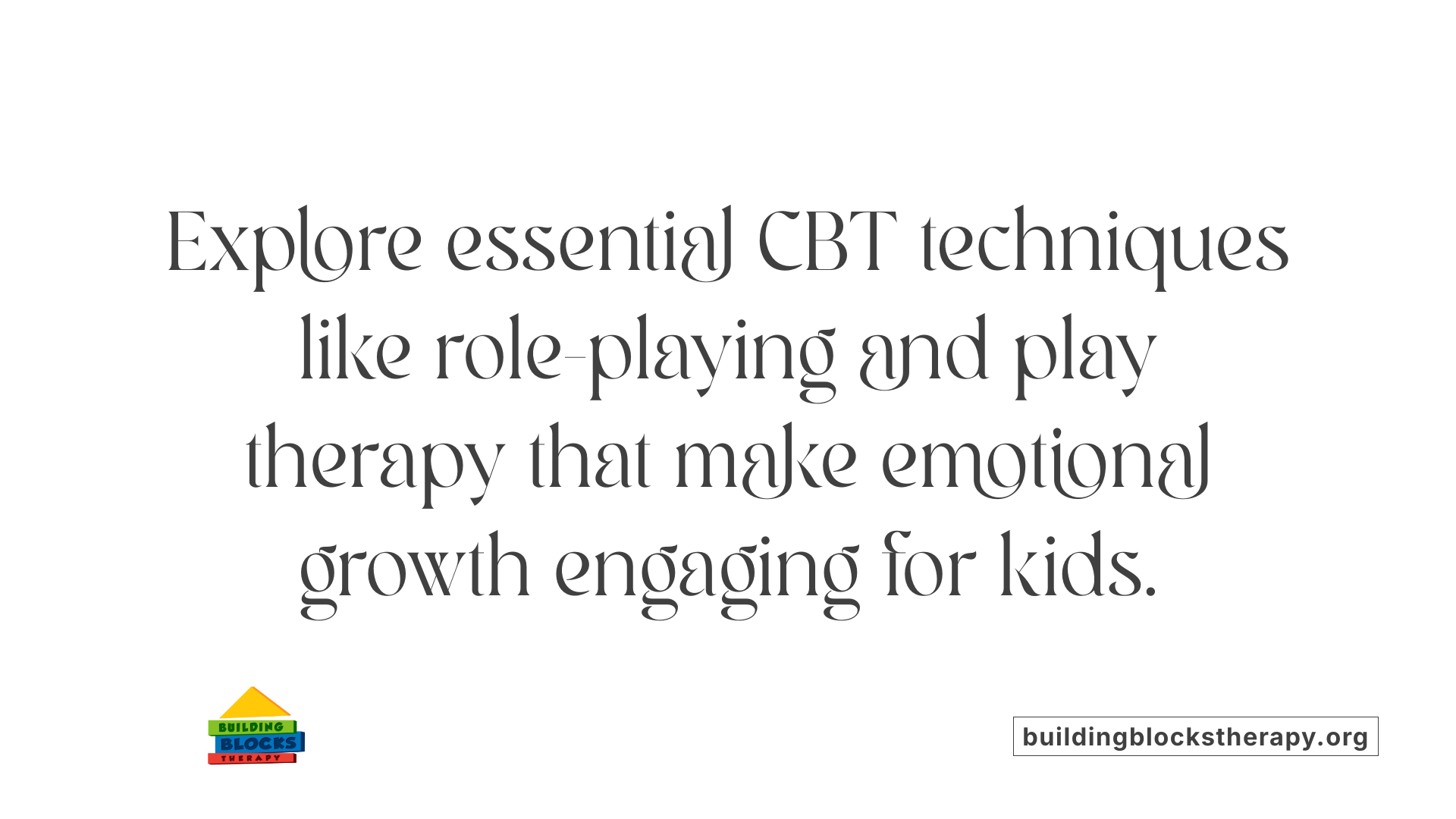
What techniques are used in CBT for children?
Cognitive Behavioral Therapy (CBT) for children employs a variety of techniques tailored to their developmental levels and specific needs. One primary approach is cognitive restructuring, which helps children identify and challenge negative or unhelpful thoughts, replacing them with healthier, more adaptive cognitions. This technique encourages children to develop better thinking patterns that influence their feelings and behaviors positively.
Behavioral strategies are also central to CBT for young clients. Techniques such as role-playing allow children to practice new behaviors in a safe environment, enhancing their social skills and confidence. Activity scheduling motivates children to engage in positive, rewarding activities, which can boost mood and decrease anxiety or depression symptoms. Modeling is another effective method where children learn by observing and imitating behaviors demonstrated by the therapist or caregivers.
For younger children, play therapy is frequently incorporated into CBT. Play provides a natural medium for children to express their emotions, process experiences, and experiment with new responses through metaphors and symbolic activities. Play-based interventions make abstract concepts more concrete, aiding understanding and engagement.
Family and caregiver involvement is vital for the success of CBT in children. Psychoeducational programs teach parents and teachers how to reinforce therapeutic strategies at home and in school settings. Techniques like Parent-Child Interaction Therapy (PCIT) improve the parent-child relationship, which in turn supports the child's behavioral changes.
Additionally, exposures and response prevention are employed for managing anxiety and obsessive-compulsive disorders, helping children confront fears gradually. Mindfulness and calming exercises derived from Dialectical Behavior Therapy (DBT) assist children in managing intense emotions.
By combining these cognitive, behavioral, play, and family-based techniques, CBT provides a comprehensive framework to help children address a range of emotional and behavioral challenges.
| Technique | Purpose | Developmental Suitability |
|---|---|---|
| Cognitive Restructuring | Change negative thoughts | Suitable for most ages, adapted for cognitive level |
| Role-Play | Practice new behaviors | Effective across age groups, especially for social skills |
| Activity Scheduling | Promote positive engagement | Good for mood improvement, applicable for various ages |
| Modeling | Learn behaviors by imitation | Suitable for early childhood to adolescence |
| Play Therapy | Express emotions, build understanding | Primarily for ages 3-8 |
| Parent–Child Interaction | Enhance family dynamics | For all young children, supports skill reinforcement |
| Exposure/Response Prevention | Reduce anxiety/OCD symptoms | For children with specific fears or compulsions |
| Mindfulness Exercises | Emotional regulation | Adapted for children’s developmental stage |
Understanding and applying these techniques appropriately enhances the effectiveness of CBT for children, promoting healthier emotional and behavioral patterns that support their development.
CBT as a Support for Emotional and Behavioral Growth in Children
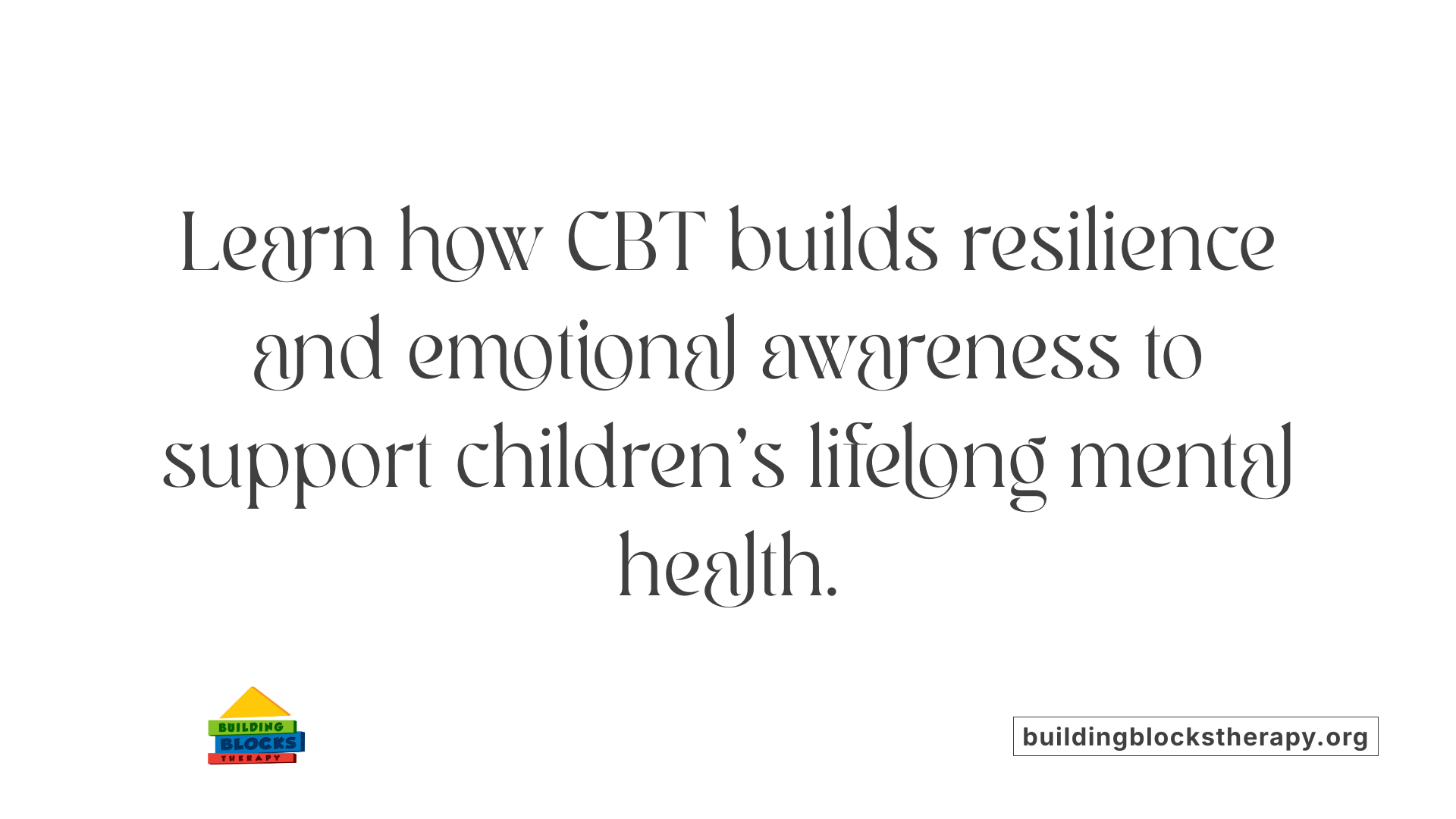
What is the role of CBT in supporting children's emotional and behavioral growth?
Cognitive-behavioral therapy (CBT) is a structured, evidence-based approach that helps children understand and manage their thoughts, feelings, and behaviors. It plays a crucial role in fostering emotional and behavioral development by guiding children to identify automatic or maladaptive thoughts that influence their mood and actions. Through techniques like cognitive restructuring and problem-solving, children learn to challenge negative beliefs and develop healthier thinking patterns.
CBT also emphasizes the importance of developing practical coping skills, such as relaxation techniques, activity scheduling, and emotional regulation strategies. These skills enable children to respond more adaptively to stressful or challenging situations, promoting resilience and self-control.
Involving family, teachers, and caregivers in CBT enhances its effectiveness, creating a supportive environment where children can practice new skills regularly. This collaborative approach helps reinforce positive behaviors and emotional responses both at school and home.
Research supports that CBT is effective for conditions like anxiety, depression, and behavioral problems in children and adolescents. When tailored to developmental levels and cultural contexts, it addresses the specific needs of young children, considering their cognitive abilities and emotional maturity.
Overall, CBT helps children build emotional awareness, develop adaptive coping mechanisms, and foster resilience. These outcomes not only improve immediate symptoms but also provide lifelong tools for managing emotional and behavioral challenges, supporting healthy psychological growth through different stages of development.
Empirical Evidence Supporting CBT’s Effectiveness in Children
What is the evidence for the effectiveness of CBT in improving mental health outcomes for children?
Research consistently demonstrates that cognitive-behavioral therapy (CBT) is an effective treatment for a variety of mental health issues in children and adolescents. Extensive meta-analyses and clinical trials have shown significant symptom reduction in conditions such as anxiety, depression, obsessive-compulsive disorder (OCD), post-traumatic stress disorder (PTSD), and behavioral problems.
For example, studies indicate that between 55% and 65% of children with anxiety disorders no longer meet clinical criteria following CBT treatment. The therapy's structured approach helps children develop coping skills, challenge negative thought patterns, and learn behavior management techniques that lead to substantial improvements.
Neuroimaging research further supports CBT’s effectiveness by revealing that treatment can normalize brain activity linked to anxiety and emotional regulation. These findings suggest that CBT not only reduces symptoms but also facilitates changes in neural pathways involved in emotional processing.
An essential factor in CBT's success is involving parents and tailoring therapy to developmental stages, making interventions more accessible and practical for children. Overall, the broad base of scientific evidence affirms that CBT is a validated and adaptable treatment capable of significantly improving mental health outcomes among young populations.
Neurobiological and Psychological Foundations of CBT
What is the neurobiological and psychological basis for CBT’s effectiveness in children?
Cognitive Behavioral Therapy (CBT) demonstrates its effectiveness in children through a combination of neurobiological and psychological mechanisms. Neuroimaging research provides compelling evidence that successful CBT treatment leads to enhanced functioning of specific brain regions involved in emotion regulation.
Key areas affected include the prefrontal cortex, particularly the ventromedial prefrontal cortex, and the anterior cingulate cortex. These regions are critical in exerting top-down control over emotional responses. During treatment, neuroimaging studies have shown increased activity and connectivity within these cortical areas, which helps children better regulate feelings like anxiety and anger.
Simultaneously, CBT appears to reduce hyperactivity in limbic regions such as the amygdala, which are involved in processing threats and fears. Diminished limbic reactivity contributes to lower levels of hyperarousal and fear responses, making emotional stimuli more manageable.
Furthermore, neuroimaging indicates that the neural circuits responsible for recognizing and interpreting emotions mature and adapt with therapy. This neural plasticity facilitates improved emotional recognition and social cognition, which are often impaired in children with behavioral or emotional disorders.
Psychologically, CBT focuses on modifying dysfunctional thought patterns and enhancing emotional awareness. These cognitive shifts are reflected in neural changes, like increased activity in cortical regions responsible for higher-order thinking and decreased activity in areas associated with reactive emotional responses.
By targeting both neural circuitry and psychosocial processes, CBT helps children develop healthier ways of processing emotions, solving problems, and managing behavior. The combined neurobiological and psychological effects form a foundation for enduring improvements in emotional regulation and social functioning.
In summary, the effectiveness of CBT in children is supported by evidence showing that it strengthens neural pathways associated with emotion regulation, reduces limbic hyperactivity, and fosters adaptive thinking, thereby translating neural changes into observable behavioral improvements.
Developmental Considerations and Tailoring CBT for Young Children
How is CBT explained to children?
Explaining CBT to young children requires using simple language and relatable concepts. One effective approach is to compare it to activities children already understand, such as sports coaching or music lessons. The therapist acts like a coach, helping children learn new skills to manage their feelings and thoughts.
Another way is to describe CBT as a tool to recognize and change unhelpful or negative thoughts—sometimes called 'bad thoughts'—that can make them feel upset or anxious. Children are taught practical strategies like relaxation techniques, role-playing, or keeping worry logs. These help them understand how their thoughts, feelings, and actions are connected.
Therapists often use the cognitive triangle—a visual model showing how thoughts, feelings, and behaviors influence each other—to make these ideas comprehensible. Metaphors like the remote control can be helpful; for example, children can learn to 'turn down' their emotions or worries just like turning down the volume on a TV.
Overall, the focus is on empowering children with skills in a fun and engaging way. Play, art, stories, and everyday scenarios are used to teach them how to manage their feelings and worries effectively. This approach makes therapy both accessible and motivating for young children, laying a foundation for emotional resilience and self-control.
Cultural and Familial Influences on CBT Outcomes
What are the signs indicating a child may benefit from CBT?
Signs that a child may benefit from Cognitive Behavioral Therapy (CBT) include persistent emotional or behavioral problems such as ongoing depression, anxiety, or trauma symptoms, especially when these interfere with daily functioning. Sudden or drastic changes in mood, withdrawal from activities, or increased aggression can indicate underlying issues requiring professional help.
Children exhibiting intense emotional reactions, irritability, or difficulty managing thoughts—such as persistent worries, irrational fears, or negative self-talk—may also benefit from CBT. Additionally, problems like difficulty with school performance, sleep or eating disturbances, or social withdrawal can be signs that therapy could support the child's emotional regulation and coping skills.
Overall, if emotional or behavioral issues are persistent, intense, or impairing a child's daily life, seeking a professional trained in CBT can be highly beneficial.
Impact of Family Attitudes
The success of CBT in children heavily depends on familial attitudes towards mental health treatment. Parental perceptions, such as overinvolvement or rejection, can significantly influence therapy outcomes. Parents who hold a positive view of mental health interventions and actively support their child's participation tend to see better results.
Conversely, negative beliefs, stigma, or denial about mental health issues can hinder engagement with therapy. Some parents may blame external factors for their child's problems or dismiss concerns altogether, which can reduce motivation for seeking or continuing treatment.
Parental Perceptions and Involvement
Active parental involvement is crucial in pediatric CBT. Parents serve as reinforcement agents outside therapy sessions, helping children practice coping skills and apply strategies at home or school. Psychoeducational programs that educate parents about mental health and CBT principles further enhance therapy outcomes.
However, parental attitudes can be complex. Overinvolved parents might inadvertently reinforce dependency, while rejecting parents may diminish a child's motivation or trust in therapy. Therefore, therapists often work to engage parents constructively, tailoring approaches to each family's context.
Cultural Considerations in Therapy
Cultural and familial variables influence how CBT is delivered and received. Cultural beliefs about mental health, emotional expression, and help-seeking behavior can affect engagement and effectiveness. For example, in some cultures, mental health issues may be highly stigmatized, leading to delays in treatment or denial.
Therapists must recognize these cultural influences and adapt their approaches accordingly. Incorporating culturally relevant language, respecting traditional beliefs, and involving family members in treatment can improve acceptance and outcomes.
In summary, understanding and integrating familial attitudes and cultural considerations are vital. They help tailor interventions that respect family dynamics and cultural backgrounds, ultimately fostering a supportive environment conducive to positive therapeutic change.
| Aspect | Influence | Approach to Support |
|---|---|---|
| Family attitudes | Can facilitate or hinder therapy | Psychoeducation, family involvement |
| Parental perceptions | Affect engagement and reinforcement | Tailored communication, building trust |
| Cultural variables | Impact acceptance and participation | Cultural adaptations, inclusive strategies |
Addressing these factors collectively supports a more effective and culturally sensitive CBT process, helping children and families achieve meaningful mental health improvements.
Implementing CBT in Various Contexts and Settings
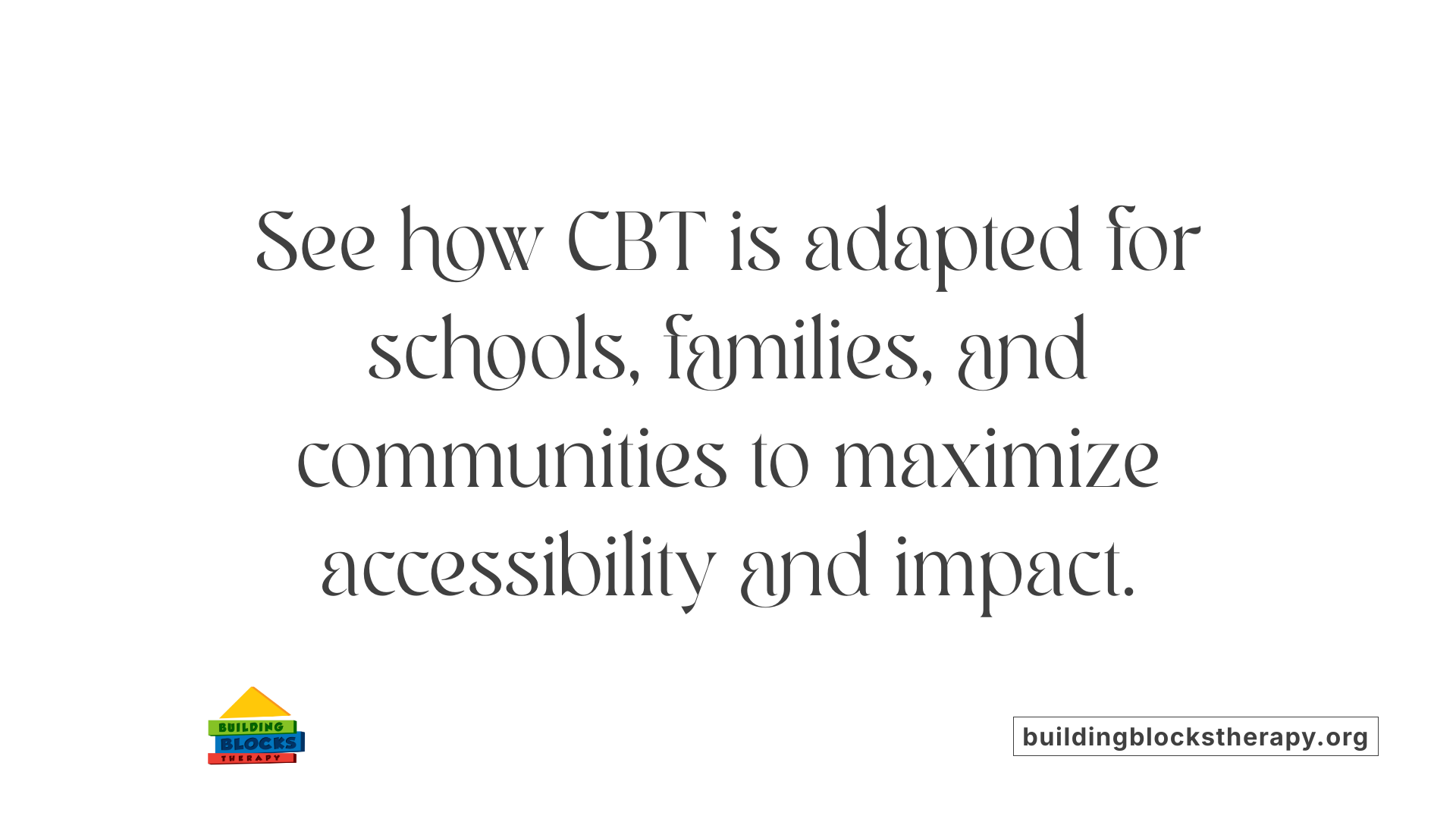 Cognitive Behavioral Therapy (CBT) has been widely adapted to fit different environments, making it accessible and effective across multiple settings such as schools, community programs, and family homes.
Cognitive Behavioral Therapy (CBT) has been widely adapted to fit different environments, making it accessible and effective across multiple settings such as schools, community programs, and family homes.
School-based interventions are increasingly common, where CBT techniques are integrated into the classroom or school counseling services. These programs focus on teaching children coping skills, emotional regulation, and problem-solving strategies to manage anxiety, stress, and behavioral problems. In this setting, group formats are popular, promoting social skills and peer support, while individual sessions can target specific issues. Teachers and school staff are often trained to reinforce therapy techniques, creating a supportive environment that fosters mental health.
Community and outpatient settings provide flexible platforms for CBT, where children and adolescents can receive tailored therapy from mental health professionals. These settings often involve a combination of individual therapy, group work, and family involvement. Community-based programs are valuable for reaching diverse populations, including those in underserved areas, and often address external factors such as environmental stressors or socio-economic challenges that impact mental health.
Family involvement and integration are crucial components of effective CBT for children. Engaging parents and caregivers in therapy helps reinforce skills learned during sessions and improves overall outcomes. Psychoeducational programs for parents increase understanding of mental health issues, while techniques like Parent-Child Interaction Therapy (PCIT) strengthen relationships and promote consistent behavior management. Family-focused interventions emphasize communication, building supportive home environments, and addressing familial or cultural variables that influence therapy success.
Play therapy and other techniques within CBT for children play a vital role in developmentally appropriate treatment. For younger children, play therapy provides a safe medium to explore emotions, process experiences, and develop new coping skills through activities like role-playing, modeling, and story-telling. Cognitive restructuring and behavioral techniques are adapted to suit children's cognitive levels, utilizing visual aids, metaphors, and play-based interventions.
Techniques such as exposure therapy, mindfulness exercises from Dialectical Behavior Therapy (DBT), and emotion regulation strategies are incorporated to target specific problems like anxiety or obsessive-compulsive behaviors. The use of play and creative arts not only makes therapy engaging for children but also helps overcome communication barriers, allowing them to express thoughts and feelings that they may not articulate verbally.
In summary, the implementation of CBT across various settings involves a combination of tailored strategies that consider developmental stages, cultural backgrounds, and family systems. Incorporating play, cognitive, behavioral, and family-based techniques ensures that interventions are effective, accessible, and developmentally appropriate, ultimately promoting better mental health outcomes in children.
The Future of CBT in Child Development and Research Directions
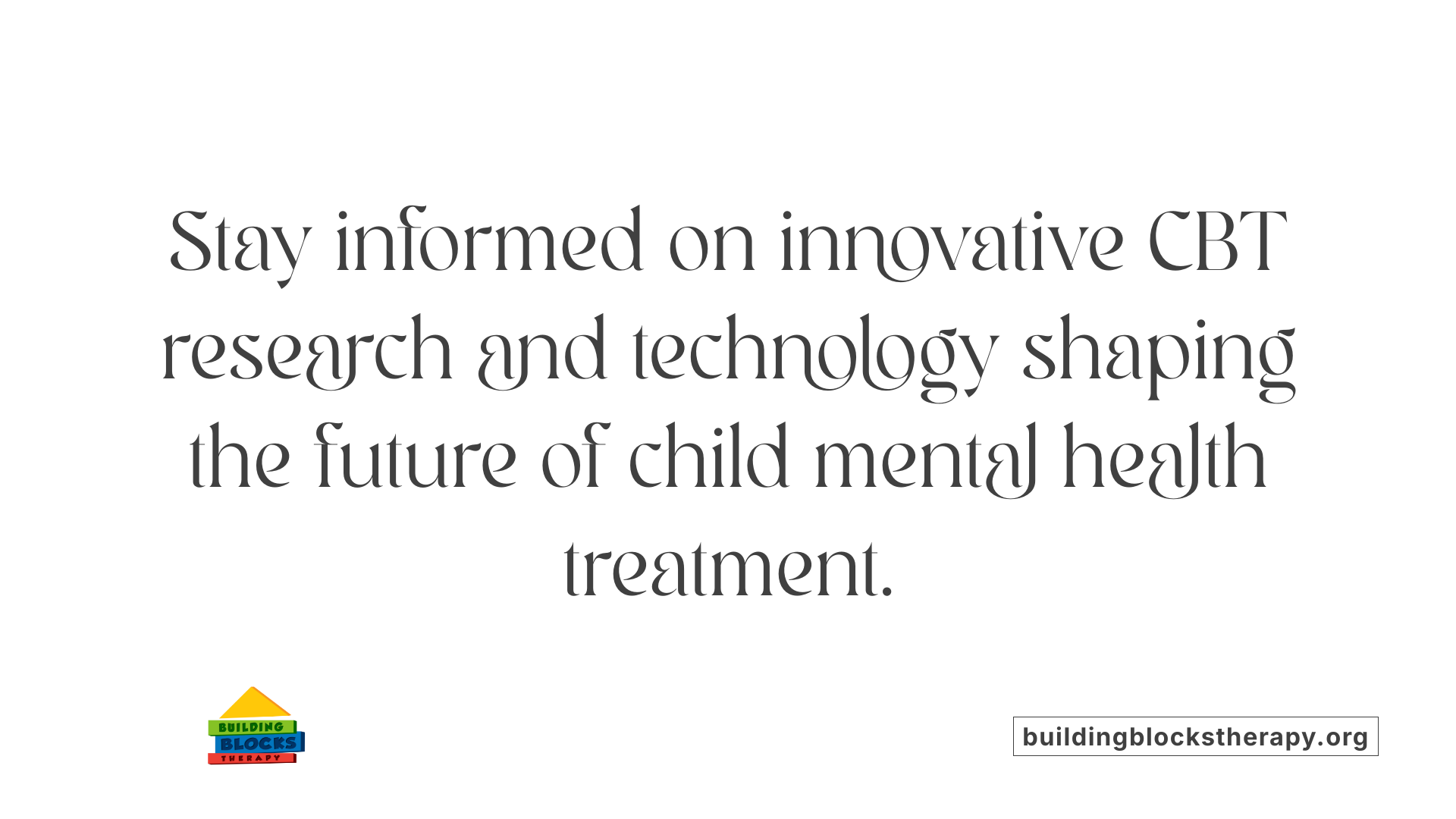
What is the evidence for the effectiveness of CBT in improving mental health outcomes for children?
Extensive research confirms that cognitive-behavioral therapy (CBT) significantly improves mental health in children and adolescents. Multiple studies, including meta-analyses and randomized controlled trials, show that CBT effectively reduces symptoms of anxiety, depression, obsessive-compulsive disorder (OCD), post-traumatic stress disorder (PTSD), and disruptive behaviors.
Response rates often range between 55% and 65%, meaning over half of the treated youth experience substantial symptom relief, with many no longer meeting psychiatric diagnostic criteria after therapy.
Neuroimaging studies add to the evidence by illustrating that CBT can normalize brain activity, especially in regions involved with anxiety and emotional regulation. Such neural changes suggest that CBT not only alleviates symptoms but may also promote adaptive changes in brain circuits.
Importantly, involving parents and tailoring therapy to developmental levels enhances outcomes. The overall body of evidence from peer-reviewed sources affirms CBT as a validated and effective approach for promoting mental health in young populations.
Innovations in therapy delivery
Advances in technology, such as online platforms and app-based interventions, offer new ways to deliver CBT. These innovations expand access, especially for children in remote areas or with limited transportation options. Virtual reality and gamified modules are also being explored to make therapy more engaging for young children.
In addition, integrating CBT with school-based programs and family involvement enhances its reach and impact. Group formats and modular, personalized treatments are increasingly common, allowing therapists to tailor interventions based on individual needs and contexts.
Integration with neuroimaging and neurocognitive research
Recent research innovations include combining CBT with neuroimaging to better understand how therapy changes brain function. Such studies reveal neural pathways involved in anxiety and depression, opening possibilities for customizing interventions. For example, neurocognitive assessments evaluating executive functions or emotional understanding help therapists identify specific deficits.
This integration can lead to the development of biomarkers for treatment response and guide targeted therapies that address underlying neurocognitive vulnerabilities, thereby improving efficacy and long-term outcomes.
Enhancing developmentally-sensitive treatment
Recognizing that children vary widely in their developmental stages, future directions emphasize creating age-appropriate and culturally sensitive interventions. For young children aged 5-8, adaptations use play, storytelling, and visual tools to facilitate understanding and skill acquisition.
Assessment tools grounded in developmental psychology are vital to tailor therapies effectively. By identifying children’s cognitive, social, and emotional abilities, clinicians can adjust the complexity and techniques employed, ensuring engagement and progress.
Ongoing research aims to refine these approaches, making CBT more accessible and effective for children with diverse backgrounds and developmental profiles. Through these innovations, CBT is poised to become an even more powerful tool for fostering mental health from early childhood onward.
Enhancing Child Well-being Through Developmentally-Informed Approaches
The role of Cognitive Behavioral Therapy in child development is both profound and multifaceted. By integrating core principles with developmentally-sensitive techniques, involving families and communities, and leveraging ongoing research, CBT continues to evolve as a cornerstone of child mental health intervention. Its capacity to foster emotional resilience, modify maladaptive thoughts, and cultivate adaptive behaviors makes it essential in nurturing well-rounded, emotionally competent individuals. As research advances and therapeutic modalities diversify, CBT’s future promises innovative, tailored strategies that can better address the complex neurobiological, cognitive, and social needs of children at every developmental stage.
References
- Cognitive Behavior Therapy for Children and Adolescents
- History of Cognitive-Behavioral Therapy (CBT) in Youth - PMC
- Is cognitive behavior therapy developmentally appropriate for young ...
- Cognitive behavioral therapy - Mayo Clinic
- Child Well-Being through Cognitive Behavioral Play Therapy
- Cognitive Behavioral Therapy (CBT)
- Cognitive behaviour therapy (CBT) - Better Health Channel
- CBT for Children: A Guide for Helping Kids in Therapy
- Does Cognitive Behavioral Therapy Work for Children






